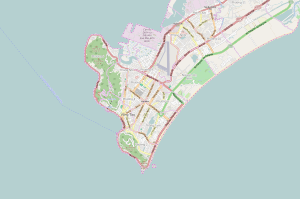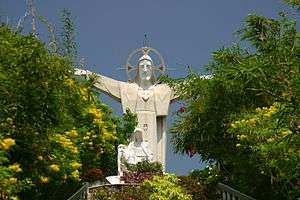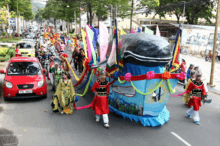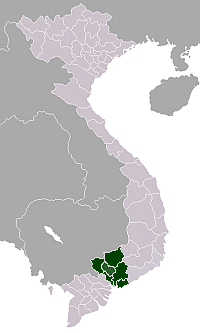Vũng Tàu
| Vũng Tàu | |
|---|---|
| Provincial city (Class-1) | |
|
Vũng Tàu, as seen from Villa Blanche | |
 Map of central Vũng Tàu | |
| Coordinates: 10°23′N 107°7′E / 10.383°N 107.117°ECoordinates: 10°23′N 107°7′E / 10.383°N 107.117°E | |
| Country |
|
| Province | Bà Rịa–Vũng Tàu Province |
| Area | |
| • Land | 54.5 sq mi (141.1 km2) |
| Population (2018) | |
| • Total | 327,000 [1] |
| • Ethnicities |
|
Vũng Tàu (Hanoi accent: [vuŋm˧ˀ˥ taːw˨˩] (![]()
![]()
Administrative divisions
16 wards: 1, 2, 3, 4, 5, 7, 8, 9, 10, 11, 12, Thắng Nhất, Thắng Nhì, Thắng Tam, Nguyễn An Ninh, Rạch Dừa and 1 commune: Long Sơn.
History

During 14th and 15th centuries, the cape that would become Vũng Tàu was a swamp which European trading ships visited regularly. The ships' activities inspired the name Vũng Tàu, which means "anchorage". The French Indochinese government named it Cap Saint-Jacques ("Cap Xanh Giac", in Vietnamese). The cliff of Vũng Tàu is now called Mui Nghinh Phong (literally meaning "Cape of breeze welcome" or "Cape of greeting the wind").
Vũng Tàu was originally referred to as Tam Thắng ("Three Boats") in memory of the first three villages in this area: Thắng Nhất, Thắng Nhị, Thắng Tam, within the province of Biên Hòa under the Nguyễn Dynasty. Under the reign of king Gia Long (1761–1820), when Malay pirates built a base here and subsequently became a danger to traders in Gia Định city, the king sent his army to crack down on the pirates. The pirates were ousted and the troops were given the land as a reward. 10 February 1859 marked the first use of cannons by Nguyễn's army, when they fired at French battleships from the fortress of Phước Thắng, located 100m from Vũng Tàu's Front Beach. This marked an important period in Vietnam's war against French invaders in South Vietnam (then called Cochinchina).
In 1876, according to a decree by the French government, Vũng Tàu was merged in Bà Rịa county per Saigon's administration. During the 1880s there talks about moving Saigon's port facilities to Vũng Tàu, but this came to nothing due to Saigon's better infrastructure.[3]
On 1 May 1895, the governor of Cochinchina established by decree that Cap Saint Jacques would thereafter be an autonomous town. In 1898, Cap Saint Jacques was merged with Bà Rịa county once again, but re-divided in 1899. In 1901, the population of Vũng Tàu was 5,690, of which 2,000 persons were immigrants from North Vietnam. Most of the town's population made their living in the dancing industry. On 4 April 1905, Cap Saint Jacques was made an administrative district of Bà Rịa province. In 1929, Cap Saint Jacques became a province, and in 1934 became a city (commune). The French governor of Indochina, Paul Doumer (who later became President of France), built a mansion in Vũng Tàu that is still a prominent landmark.
During the Vietnam War, the 1st Australian Logistics Support Group was headquartered in Vũng Tàu – as were various United States military units at different times. Vũng Tàu also became popular for R&R, amongst in-country US, Australian and New Zealand personnel.[4]
After the war, Vũng Tàu was a common launching place for the "Vietnamese boat people" fleeing the communists. On 30 May 1979, Vũng Tàu town was made the capital of Vũng Tàu-Côn Đảo Special Administrative Zone. On 12 August 1991, Bà Rịa–Vũng Tàu Province was officially founded and Vũng Tàu town officially became Vũng Tàu City.
Economy and tourism
Shipping and oil exploration
The city is located in the south of Vietnam, situated at the tip of a small peninsula. It has traditionally been a significant port, particularly during Vietnam's period of French rule. Today, the city's importance as a shipping port has diminished, but it still plays a significant role in Vietnam's offshore oil industry. Vũng Tàu is the only petroleum base of Vietnam where crude oil and natural gas exploitation activities dominate the city's economy and contribute principal income to Vietnam's budget and export volume. Vũng Tàu shipyard's reconstruction is scheduled to be completed in 2008, supplied with up-to-date anchor handling supply vessels of Aker.[5]
Industry
PEB Steel operates several factories in Vũng Tàu, for constructing steel buildings to be erected around Asia.[6][7]
Beaches
Vũng Tàu has extensive beaches, including Back Beach (Bãi Sau) and Front Beach (Bãi Trước).
Resorts and theme parks
A big resort project has just been licensed by the Vietnamese government, the Saigon Atlantis. Upon completion, this entertainment project worth US$300 million in capital investment will include resorts, shopping, sailing.[8] The investor of this project is proposing to raise the investment capital to USD $4 billion. Two other noteworthy entertainment projects awaiting licensing are Vũng Tàu Aquarium, which will cost USD 250 million, and Bàu Trũng, a Disneyland-like entertainment park which will cost US$250 million. The project includes Landmark Tower, an 88-story skyscraper proposed to be built and completed by 2010 in Vũng Tàu by a USA-based company, Good Choice Import – Export Investment Inc, once built will likely be the highest building in Vietnam. The project is under consideration for approval by the local provincial government.[9][10]
Holidays and festivals
In Vũng Tàu, one of the most widely celebrated holidays is Lễ hội Cá Ông (Whale Holiday). Festivals in the region include the Kite Festival and World Food Festival Culture[11] Australian tourists come to Vũng Tàu in August to mark the anniversary of the Battle of Long Tan.
Religion

As in most provinces and cities in Vietnam, Buddhism is the predominant religion. Mahayana Buddhism, the dominant form of the religion in Vietnam, was brought to Ba Ria-Vũng Tàu by the Vietnamese settlers from the north at the beginning of the 17th century during the expansion of the Nguyễn lords. When they came bringing their original religion they built many Buddhist pagodas, temples and statues in the city. The Thích Ca Phật Đài and Niết Bàn Tịnh Xá temple, both Buddhist sites, draw pilgrims from around the country.[12]
Before the area was settled by ethnic Vietnamese, the Khmer people practiced Theravada Buddhism. The area has some 14 Catholic wards with active services.[13] A notable monument in the city is the Christ of Vũng Tàu, a large statue built by Vietnam's Catholic minority. It was completed in 1974, with the height of 32 metres and two outstretched arms spanning 18.4 metres. It is among the tallest statues of Christ in Asia.[14]
There has been a Russian village in Vũng Tàu ever since the Soviet era; these Russians generally worked for the Russian-Vietnamese joint venture VietSovpetro. It is believed that these "Russians", or "citizens of the former Soviet Union", were once the most dominant group of foreigners in Vũng Tàu. Some have remained in Vũng Tàu after the dissolution of the Soviet Union. They formed a parish of the Russian Orthodox Church.
One of the Vietnamese whale worship sites, the Lang Ong Nam Hai Whale Temple hosts a skeleton of a whale, being respected in the name of Nam Hai General, a whale god. Nam Hai General is said to govern the ocean and protect people from evils, monsters, and disasters, and an Annual festival is held in commemoration. See also Vietnamese folk religion.
Climate
| Climate data for Vũng Tàu | |||||||||||||
|---|---|---|---|---|---|---|---|---|---|---|---|---|---|
| Month | Jan | Feb | Mar | Apr | May | Jun | Jul | Aug | Sep | Oct | Nov | Dec | Year |
| Record high °C (°F) | 32.5 (90.5) |
32.9 (91.2) |
34.2 (93.6) |
36.2 (97.2) |
36.0 (96.8) |
34.7 (94.5) |
33.8 (92.8) |
33.8 (92.8) |
33.8 (92.8) |
33.3 (91.9) |
33.7 (92.7) |
32.8 (91) |
36.2 (97.2) |
| Average high °C (°F) | 29.1 (84.4) |
29.4 (84.9) |
30.5 (86.9) |
31.8 (89.2) |
32.1 (89.8) |
31.5 (88.7) |
30.8 (87.4) |
30.8 (87.4) |
30.6 (87.1) |
30.3 (86.5) |
30.1 (86.2) |
29.5 (85.1) |
30.5 (86.9) |
| Daily mean °C (°F) | 25.0 (77) |
25.4 (77.7) |
26.7 (80.1) |
28.2 (82.8) |
28.5 (83.3) |
27.7 (81.9) |
27.1 (80.8) |
27.0 (80.6) |
26.9 (80.4) |
26.7 (80.1) |
26.4 (79.5) |
25.4 (77.7) |
26.7 (80.1) |
| Average low °C (°F) | 22.8 (73) |
23.7 (74.7) |
25.3 (77.5) |
26.6 (79.9) |
26.4 (79.5) |
25.6 (78.1) |
25.1 (77.2) |
25.2 (77.4) |
25.0 (77) |
24.8 (76.6) |
24.3 (75.7) |
23.1 (73.6) |
24.8 (76.6) |
| Record low °C (°F) | 16.8 (62.2) |
18.4 (65.1) |
16.8 (62.2) |
21.0 (69.8) |
18.7 (65.7) |
17.9 (64.2) |
20.0 (68) |
18.2 (64.8) |
18.6 (65.5) |
19.0 (66.2) |
17.1 (62.8) |
15.0 (59) |
15.0 (59) |
| Average precipitation mm (inches) | 2 (0.08) |
0 (0) |
5 (0.2) |
28 (1.1) |
191 (7.52) |
216 (8.5) |
234 (9.21) |
212 (8.35) |
233 (9.17) |
236 (9.29) |
66 (2.6) |
14 (0.55) |
1,437 (56.57) |
| Average precipitation days | 0.9 | 0.2 | 0.8 | 3.7 | 13.9 | 18.6 | 20.0 | 18.5 | 18.8 | 17.0 | 7.3 | 3.1 | 122.8 |
| Average relative humidity (%) | 78.3 | 78.5 | 78.6 | 78.1 | 80.5 | 83.6 | 84.8 | 85.4 | 86.1 | 85.7 | 82.1 | 79.9 | 81.8 |
| Mean monthly sunshine hours | 264 | 258 | 294 | 274 | 232 | 197 | 211 | 191 | 185 | 190 | 209 | 224 | 2,728 |
| Source: Vietnam Institute for Building Science and Technology[15] | |||||||||||||
Transport
From Hồ Chí Minh City, it takes about two hours to reach Vũng Tàu by road (51A Expressway), or one hour 30 minutes by high speed ferry,[16] or one and half hour by car on freeway.
Twin towns – sister cities
Vũng Tàu is twinned with:
|
A street in Baku is named after Vũng Tàu, while Vũng Tàu has a street named Baku.[20] This commemorates the cooperation in petroleum extraction between Soviet Azerbaijani and Vietnamese specialists in Vũng Tàu in the 1980s.[20]
References
- ↑ "Giới thiệu thành phố Vũng Tàu" [Introduction of Vũng Tàu city] (in Vietnamese). People's Committee of Bà Rịa–Vũng Tàu Province. Retrieved 5 January 2017.
- ↑ Overview of cua lo beach in Vietnamese on official website
- ↑ Saigon: A History, p. 82, by Nghia M. Vo (2011): "There were talks about moving the port facilities to Vũng Tàu at the mouth of the river where ..."
- ↑ Keith W. Nolan. Search and Destroy: The Story of an Armored Cavalry Squadron 2010, p. 35: "Harrington anticipated rendezvousing with his vehicles, supplies, and troops at the port city of Vũng Tàu in III Corps, then launching operations north-west of Sài Gòn with the 25th Division."
- ↑ "Shipping, shipbuilding, offshore news". Marinelog. 3 May 2007. Retrieved 1 June 2007.
- ↑ PEB Steel (3 April 2006). "Second Factory Commissioned by PEB Steel" (Press release).
- ↑ "Steel firm opens fabrication plant". Viet Nam News. Intellasia. 11 September 2009. Archived from the original on 16 June 2013. Retrieved 22 October 2012.
- ↑ "Cua Lap Resort; US$ 273 million beach resort in Vung Tau, Vietnam". Vietnam Venture Group.
- ↑ Official website of Ba Ria-Vũng Tàu Province's government
- ↑ "Tin tức, Thời sự cập nhật liên tục 24x7". VietNamNet. 18 December 2013. Archived from the original on 18 December 2013.
- ↑ World Food Festival Culture, online news.
- ↑ "Beliefs in Vung Tau". Ba Ria-Vũng Tàu Tourism.
- ↑ "Catholic Churches in Vietnam". Vietnamese Missionaries in Asia. Retrieved 1 June 2007.
- ↑ One of Asia's tallest Jesus statues graces Indonesian city, Reuters, December 2007
- ↑ "Vietnam Building Code Natural Physical & Climatic Data for Construction" (PDF) (in Vietnamese). Vietnam Institute for Building Science and Technology. Archived from the original (PDF) on 22 July 2018. Retrieved 22 July 2018.
- ↑ http://greenlines-dp.com/en/about
- ↑ "Parramatta City Hoists Vietnamese Flag | Parramatta City Council". www.parracity.nsw.gov.au. Retrieved 2015-09-04.
- ↑ "Twin-cities of Azerbaijan". Azerbaijans.com. Retrieved 2013-08-09.
- ↑ "Archived copy". Archived from the original on 2014-01-04. Retrieved 2012-12-28.
- 1 2 Третий Баку (in Russian). Азербайджанский Конгресс. 20 Feb 2014. Retrieved 20 Feb 2015.
External links
| Wikimedia Commons has media related to Vũng Tàu. |
| Wikivoyage has a travel guide for Vung Tau. |
- Official website (in Vietnamese)
